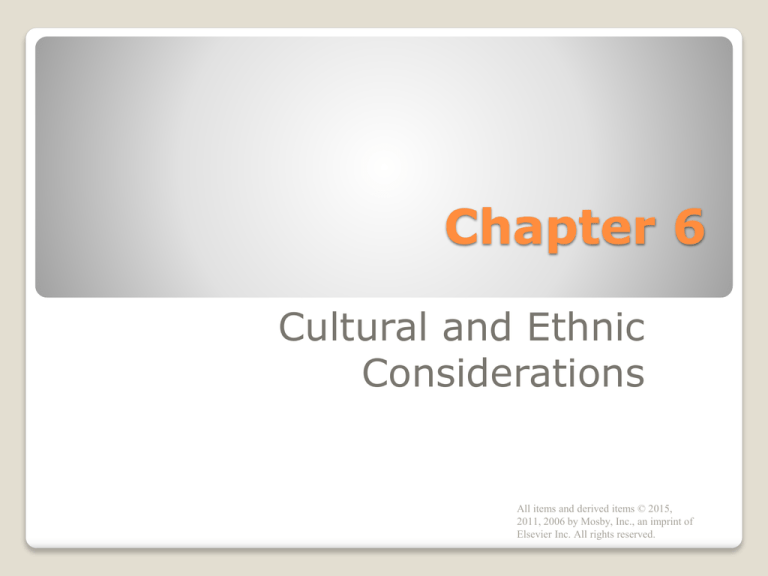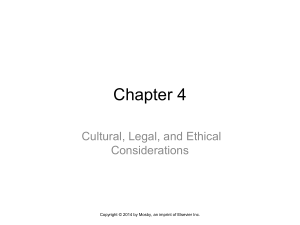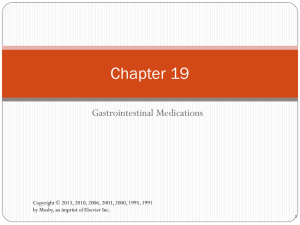
Chapter 6
Cultural and Ethnic
Considerations
All items and derived items © 2015,
2011, 2006 by Mosby, Inc., an imprint of
Elsevier Inc. All rights reserved.
United States described as “melting pot”
from many different countries
According to 2010 census, 34.6% of
population is of African, Asian, Hispanic,
American Indian, or some other ancestry
(U. S. Census Bureau, 2010)
Overview
All items and derived items © 2015,
2011, 2006 by Mosby, Inc., an imprint of
Elsevier Inc. All rights reserved.
2
Set of learned values, beliefs, customs,
and practices that are shared by a group
and passed from one generation to
another
Subculture
◦ Share characteristics with primary culture
◦ Has characteristic patterns of behavior and
ideals that distinguish it from the rest of
cultural group
Culture Defined
All items and derived items © 2015,
2011, 2006 by Mosby, Inc., an imprint of
Elsevier Inc. All rights reserved.
3
Characteristics
Differences
Age
Religion
Dialect or language spoken
Gender identity and roles
Socioeconomic background
Geographic location of country of origin or current
residence
Amount and type of interaction between younger and older
generations
◦ Degree to which values in current country are adopted
Culture Defined cont’d
All items and derived items © 2015,
2011, 2006 by Mosby, Inc., an imprint of
Elsevier Inc. All rights reserved.
4
Nurses need to deliver culturally
competent care and avoid stereotyping
Stereotype
◦ Generalized expectation about forms of
behavior, an individual, or a group
Ethnic stereotype
◦ Fixed concept of how all members of an ethnic
group act or think
Culture Defined cont’d
All items and derived items © 2015,
2011, 2006 by Mosby, Inc., an imprint of
Elsevier Inc. All rights reserved.
5
Transcultural nursing
◦ Understanding and integrating variables into all
aspects of nursing care
◦ Nursing areas influenced by culture
Treatment methods
Responses to illness and death
Childbirth
Diet and nutrition
Culture Defined cont’d
All items and derived items © 2015,
2011, 2006 by Mosby, Inc., an imprint of
Elsevier Inc. All rights reserved.
6
Race and ethnicity
◦ Race
Group of people who share biologic physical
characteristics and hereditary factors
◦ Ethnicity
Group of people who share a common social and
cultural heritage based on shared traditions,
national origin, and physical and biologic
characteristics
Culture Defined cont’d
All items and derived items © 2015,
2011, 2006 by Mosby, Inc., an imprint of
Elsevier Inc. All rights reserved.
7
Ethnic and racial groups in the United
States
◦ Many cultures
Belong to one or more subculture
Important not to make assumptions about
a patient’s belief or practice based on
name, skin color, or language
Culture Defined cont’d
All items and derived items © 2015,
2011, 2006 by Mosby, Inc., an imprint of
Elsevier Inc. All rights reserved.
8
Culture is defined as a:
1. set of learned values, beliefs, customs, and
practices that are shared by a group and
passed from one generation to another.
2. set of values that has been passed on from
one generation to another.
3. group that shares biologic physical
characteristics.
Question 1
All items and derived items © 2015,
2011, 2006 by Mosby, Inc., an imprint of
Elsevier Inc. All rights reserved.
9
Communication
◦
◦
◦
◦
Nurse and patient must understand each other
Do not assume patient/family understand
Keep questions brief and simple
Nurse is responsible for providing information
to patient
◦ Different cultural groups interpret different
meanings for same words
Cultural-Related Assessment
All items and derived items © 2015,
2011, 2006 by Mosby, Inc., an imprint of
Elsevier Inc. All rights reserved.
10
Communication
◦ Silence—May indicate lack of understanding,
stubbornness, apprehension, discomfort,
agreement, disagreement, respect, or disdain
In American Indian, Chinese, and Japanese
cultures, silence allows listener to consider what
speaker has said
For Russians, French, and Spanish, silence
indicates consensus among parties
In Asian cultures, silence is a sign of respect
In Mexican culture, silence may indicate
disagreement with person of authority
Cultural-Related Assessment
cont’d
All items and derived items © 2015,
2011, 2006 by Mosby, Inc., an imprint of
Elsevier Inc. All rights reserved.
11
Communication
◦ Nonverbal
Some cultures more comfortable with touching or
maintaining eye contact
Touch is culturally related
Eye contact has significant cultural interpretations
Cultural-Related Assessment
cont’d
All items and derived items © 2015,
2011, 2006 by Mosby, Inc., an imprint of
Elsevier Inc. All rights reserved.
12
Communication
◦ Nonverbal
In United States, maintaining eye contact
indicates openness, interest in others,
attentiveness, and honesty. Lack of eye
contact—sign of shyness, humility, guilt,
embarrassment, rudeness, thoughtlessness, or
dishonesty
Asians and American Indians: sustained eye
contact—impoliteness or invasion of privacy
East Indian cultures: avoid with people of
lower or higher socioeconomic classes
All items and derived items © 2015,
2011, 2006 by Mosby, Inc., an imprint of
Appalachian: sustained eye contact—hostility
Elsevier Inc. All rights reserved.
or aggressiveness
Cultural-Related Assessment
cont’d
13
Space
◦ Different comfort areas for personal space
Western culture: more comfortable when
maintaining 3-6 feet during conversation
Body movements are culturally related
Cultural-Related Assessment
cont’d
All items and derived items © 2015,
2011, 2006 by Mosby, Inc., an imprint of
Elsevier Inc. All rights reserved.
14
Time
◦ Different meanings in various cultures
Northern European and United States give high
priority to being on time
Eastern cultures more flexible
Asians spend time getting to know someone and
view abrupt endings as rude
Mexican-Americans focus on current activity
rather than previously planned activities
Cultural-Related Assessment
cont’d
All items and derived items © 2015,
2011, 2006 by Mosby, Inc., an imprint of
Elsevier Inc. All rights reserved.
15
Social organization
◦ Socially acquired, not genetically inherited
Patriarchal: men (often oldest) make most
decisions
Matriarchal: women make decisions about health
care, provide care, and discipline
Knowing family structure assists in understanding
the patient
Cultural-Related Assessment
cont’d
All items and derived items © 2015,
2011, 2006 by Mosby, Inc., an imprint of
Elsevier Inc. All rights reserved.
16
Religious beliefs and health care
◦ Entwined with cultural beliefs
◦ Some expect members to adhere to religion
◦ Nursing care affected by religious beliefs and
practices
◦ Be aware of such beliefs to ensure care
provided is sensitive to patient’s needs
Cultural-Related Assessment
cont’d
All items and derived items © 2015,
2011, 2006 by Mosby, Inc., an imprint of
Elsevier Inc. All rights reserved.
17
Health practices
◦
◦
◦
◦
Biomedical health belief system
Folk health belief system
Holistic health belief system
Alternative or complementary belief system
Cultural-Related Assessment
cont’d
All items and derived items © 2015,
2011, 2006 by Mosby, Inc., an imprint of
Elsevier Inc. All rights reserved.
18
Biological variations
◦ Cultural groups are identified in various ways
Characteristics
◦ Body structure
◦ Skin color
◦ Hair color and texture
◦ Family history of disease
◦ Dietary practices
Cultural-Related Assessment
cont’d
All items and derived items © 2015,
2011, 2006 by Mosby, Inc., an imprint of
Elsevier Inc. All rights reserved.
19
Today you are caring for an American
Indian patient. During your communication,
you maintain eye contact, which is
perceived by this population as being:
1.
2.
3.
4.
impolite or invading privacy.
interested.
attentive.
honest.
Question 2
All items and derived items © 2015,
2011, 2006 by Mosby, Inc., an imprint of
Elsevier Inc. All rights reserved.
20
Nurse develops a care plan based on cultural
background after assessing patient
North American Nursing Diagnosis Association
(NANDA) nursing diagnoses may not apply to
culturally diverse patients
To provide care and lessen limitations of the
NANDA nursing diagnoses, the nurse must
evaluate behavior of the prospective patient’s
culture
Nursing
and or both may
The nurse,Process
health care system,
be requiredFactors
to change in order to
Cultural
All items and derived items © 2015,
accommodate, maintain, or reinforce
patients’
2011, 2006 by Mosby, Inc., an imprint of
Elsevier Inc. All rights reserved.
health beliefs and practices
21
See Table 6-4 in Foundations text
Mexican Americans
◦
◦
◦
◦
Health belief system
Language
Communication
Family roles
Cultural Practices of
Specific Groups
All items and derived items © 2015,
2011, 2006 by Mosby, Inc., an imprint of
Elsevier Inc. All rights reserved.
22
Mexican Americans
◦ Birth rites
◦ Death rites
◦ Dietary practices
Cultural Practices of Specific
Groups cont’d
All items and derived items © 2015,
2011, 2006 by Mosby, Inc., an imprint of
Elsevier Inc. All rights reserved.
23
African Americans
◦
◦
◦
◦
Health belief system
Language
Communication
Family roles
Cultural Practices of Specific
Groups cont’d
All items and derived items © 2015,
2011, 2006 by Mosby, Inc., an imprint of
Elsevier Inc. All rights reserved.
24
African-Americans
◦ Birth rites
◦ Death rites
◦ Dietary practices
Cultural Practices of Specific
Groups cont’d
All items and derived items © 2015,
2011, 2006 by Mosby, Inc., an imprint of
Elsevier Inc. All rights reserved.
25
Chinese Americans
◦ Health belief system
◦ Language
◦ Communication
Cultural Practices of Specific
Groups cont’d
All items and derived items © 2015,
2011, 2006 by Mosby, Inc., an imprint of
Elsevier Inc. All rights reserved.
26
Chinese Americans
◦
◦
◦
◦
Family roles
Birth rites
Death rites
Dietary practices
Cultural Practices of Specific
Groups cont’d
All items and derived items © 2015,
2011, 2006 by Mosby, Inc., an imprint of
Elsevier Inc. All rights reserved.
27
Muslim Americans
◦ Health belief system
◦ Language
◦ Communication
Cultural Practices of Specific
Groups cont’d
All items and derived items © 2015,
2011, 2006 by Mosby, Inc., an imprint of
Elsevier Inc. All rights reserved.
28
Muslim Americans
◦
◦
◦
◦
Family roles
Birth rites
Death rites
Dietary practices
Cultural Practices of Specific
Groups cont’d
All items and derived items © 2015,
2011, 2006 by Mosby, Inc., an imprint of
Elsevier Inc. All rights reserved.
29
American Indians
◦ Health belief system
◦ Language
◦ Communication
Cultural Practices of Specific
Groups cont’d
All items and derived items © 2015,
2011, 2006 by Mosby, Inc., an imprint of
Elsevier Inc. All rights reserved.
30
American Indians
◦
◦
◦
◦
Family roles
Birth rites
Death rites
Dietary practices
Cultural Practices of Specific
Groups cont’d
All items and derived items © 2015,
2011, 2006 by Mosby, Inc., an imprint of
Elsevier Inc. All rights reserved.
31
Which culture allows fathers in labor and
delivery?
1.
2.
3.
4.
Chinese
American Indian
Mexican Americans
Muslim
Question 3
All items and derived items © 2015,
2011, 2006 by Mosby, Inc., an imprint of
Elsevier Inc. All rights reserved.
32





